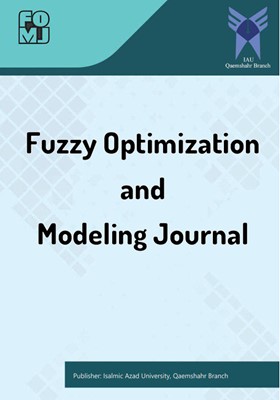Fuzzy Analysis of the Influence of Factors on the Integration of Telecommunication Technology Infrastructure Using ANFIS
Subject Areas : Fuzzy Optimization and Modeling Journal
Reza Talebi
1
*
![]() ,
Abbas Khamseh
2
,
Mohammadhassan Cheraghali
3
,
Abbas Khamseh
2
,
Mohammadhassan Cheraghali
3
1 - Department of Technology Management, Roudehen Branch, Islamic Azad University, Roudehen, Iran
2 - Department of Industrial Management, Karaj Branch, Islamic Azad University, Karaj, Iran
3 - Department of Industrial Management, South Tehran Branch, Islamic Azad University, Tehran, Iran
Keywords: ANFIS, Neural network, Technology Management, fuzzy Delphi, infrastructure integration,
Abstract :
The issue of integration in different industries is very important and brings many benefits at different economic and social levels. Given the size of the telecommunications industry, this industry is no exception to this rule and the integration of telecommunications infrastructure creates a lot of added value. But the interactions between tangible and intangible indicators have emerged by doing so, which policymakers must consider. Our goal is to study the integration of telecommunications infrastructure and study its interactions on factors identified by experts and then verified. To achieve the correct result, after collecting the opinions of industry experts, using the fuzzy Delphi method and after the steps of this method, the effective factors were examined and the basic indicators that should be considered were identified and ranked. Classified. Then, in order to determine the effect of each of the indicators on the integration of telecommunication technology infrastructure, by combining fuzzy logic and the formation of a neural network through the mathematical method of Enfis, the extent and how the effect of all factors was examined. These results are a new approach in the telecommunications industry and design an innovative model for this industry.
1. Antle, J. M., Basso, B., Conant, R. T., Godfray, H. C. J., Jones, J. W., Herrero, M., & Wheeler, T. R. (2017). Towards a new generation of agricultural system data, models and knowledge products: Design and improvement. Agricultural Systems, 155, 255-268.
2. Beydokhti, A. H. S., Bahrami, H., & Asnaashari, E. (2016) Building Information Modeling Implementation in Iran Review, The first international conference and the third national conference on construction and project management.
3. Blair, R. D., & Lafontaine, F. (2005). The economics of franchising. Cambridge University Press.
4. Chaffey, D., & Smith, P. R. (2022). Digital marketing excellence: planning, optimizing and integrating online marketing. Taylor & Francis.
5. Crespi, G., & Dutrénit, G. (2014). Introduction to science, technology and innovation policies for development: The Latin American experience. In Science, Technology and Innovation Policies for Development: The Latin American Experience (pp. 1-14). Cham: Springer International Publishing.
6. Farisi, M. (2016). Developing the 21st-century social studies skills through technology integration. Turkish online journal of Distance Education, 17(1), 16-30.
7. Gann, D. M., Dodgson, M., & Bhardwaj, D. (2011). Physical–digital integration in city infrastructure. IBM Journal of Research and Development, 55(1.2), 8-1.
8. Georg, R. (2023). Why are management skills important for engineers, Brown School of Engineering, www. engineering.rice.edu.
9. Janssen, S. J., Porter, C. H., Moore, A. D., Athanasiadis, I. N., Foster, I., Jones, J. W., & Antle, J. M. (2017). Towards a new generation of agricultural system data, models and knowledge products: Information and communication technology. Agricultural Systems, 155, 200-212.
10. Khan, S. (2014). A model for integrating ICT into teacher training programs in Bangladesh based on TPCK. International Journal of Education and Development using ICT, 10(3).
11. Litvinenko, V., Bowbriсk, I., Naumov, I., & Zaitseva, Z. (2022). Global guidelines and requirements for professional competencies of natural resource extraction engineers: Implications for ESG principles and sustainable development goals. Journal of Cleaner Production, 338, 130530.
12. Liu, Y., Huang, T. T., & Zheng, X. (2022). A method of linking functional and structural connectivity analysis in urban green infrastructure network construction. Urban Ecosystems, 25(3), 909-925.
13. Matalqah, M. M., & Warad, T. M. (2017). The impact of telecom infrastructure on the economic growth: The case of oil-producing and non-oil producing Arab Countries. International Journal of Economics and Financial Issues, 7(3), 423-428.
14. Minoli, D., & Occhiogrosso, B. (2019). Practical aspects for the integration of 5G networks and IoT applications in smart cities environments. Wireless Communications and Mobile Computing, 2019.
15. Mostakin, A. (1995). A comparison between the number of telecommunication antennas in Iran and other countries, Digiato, 95, 1-10.
16. Ng, W. S., & Acker, A. (2018). Understanding urban travel behaviour by gender for efficient and equitable transport policies. International Transport Forum Discussion Paper.
17. Oyeniran, W. I., & Onikosi-Alliyu, S. (2016). Information and telecommunication infrastructure and economic growth: An experience from Nigeria. Serbian Journal of Management, 11(2), 275-289.
18. Roelich, K., Knoeri, C., Steinberger, J. K., Varga, L., Blythe, P. T., Butler, D., & Purnell, P. (2015). Towards resource-efficient and service-oriented integrated infrastructure operation. Technological Forecasting and Social Change, 92, 40-52.
19. Shoukat, A., Ahmad, Kh., &Abdullah, Mu. (2016). Does Infrastructure Development Promote Regional Economic Integration? CPEC's Implications for Pakistan, 32nd AGM and Conference, Turkey.
20. Snowden, K. (2007). Competitiveness Review: An International Business Journal Changes Publisher. Competitiveness Review: An International Business Journal, 17(1.2).
21. Talebi, R., Khamseh, A., & Cheraghali, M. H. (2019). Policy solutions for integration of the technological infrastructure of mobile telecom operators sites, International Transaction Journal of Engineering, 10(14), 445-453.
22. Webb, H. W., & Webb, L. A. (2004). Site Qual: an integrated measure of Web site quality. Journal of Enterprise Information Management, 17(6), 430-440.
23. Wilbanks, T. J. (2017). Integrating infrastructures in the United States: experience and prospects. People, Place, 11(1), 221-230.

